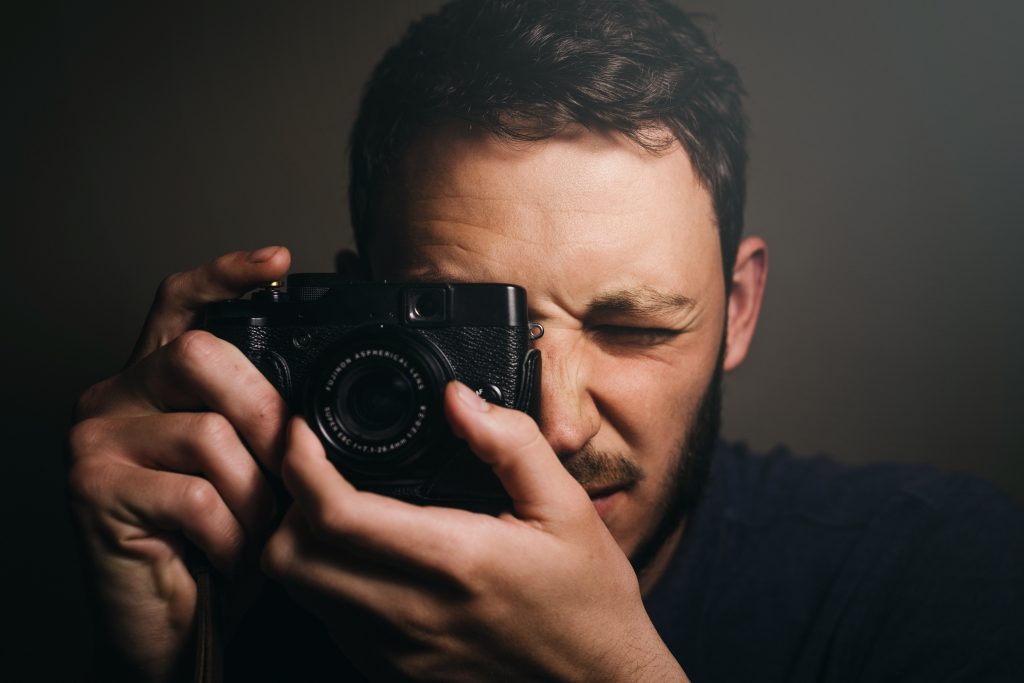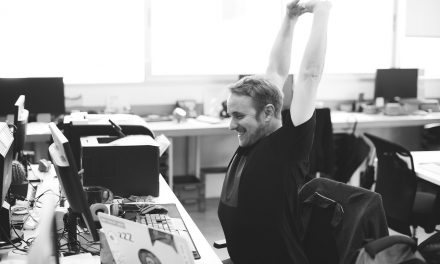Starting a career in photography is tough, and if you don’t have any experience, it might be hard to find a permanent position. More and more photographers are looking towards the freelance lifestyle. It offers more flexibility in your working hours, there’s potential for more pay, and it gives you the freedom to work with lots of different clients and on lots of different projects. But how can you get started finding work, and make a living as a freelancer in portraiture?

photo by: Alexander Andrews
Build your portfolio
The first step is absolutely to start building your portfolio. In most cases, this is something that you will have to do in your own time and with your own money – you’re very unlikely to find paid work if you don’t have the portfolio to prove that you can deliver.
Start out by looking for models on networks like StarNow, ModelMayhem, and PurplePort. These sites have profiles of models from many stages of experience, from top models signed with agencies through to beginners who are starting out, just like you. It’s easy to get started on your portfolio by setting up photo shoots with beginners like these, on a TFP basis. TFP stands for ‘time for prints’, meaning that each of you provides your time and effort for free in exchange for getting the images at the end.
Building your portfolio is all about setting up your best possible images, and also about learning and gaining experience. The more you learn about taking portraits, the better you will be at it. You will develop your own style, get better at working with other people, and put together a collection of high-quality images. All of this will really help you to find freelance work going forwards.
Gain more experience
One of the best ways to gain experience as a portrait photographer is to assist an established professional. This work may be paid or an unpaid internship, depending on the opportunities that you are able to find. Keep this in mind, as you might need to budget carefully – or even find part-time paid work to get you through this period.
However, not everyone who becomes a successful portrait photographer has done assisting work. It’s down to whether you feel it will help your career or not. A few of the benefits you may find are as follows:
- Gaining real experience of commercial or otherwise paid photoshoots
- Getting to make contacts such as models, makeup artists, and clients who you may be able to work with when you strike out alone
- Seeing how things work from the inside, which will give you insights into what is needed to make shoots work as well as practical matters like how much you should charge for your work
- Learning hands-on how to use studio lighting, photography equipment, and other things you may never have come into contact with before
- Some photographers may allow their assistants a short time to work on their own photographs during each shoot, or give them access to a studio for free
On the other hand, the downsides you may experience are as follows:
- You may not be able to share any work you do, to avoid conflict with the photographer
- Your work may not always be credited
- You may be unpaid or only receive cover for your expenses
- The hours can be long and unpredictable, making it hard to do your own work
- You may not be growing your own portfolio during this time
- Some photographers may restrict your access to contacts or even require that you sign a contract saying you will not work with them independently
- Assistant positions can be few and far between, making them hard to get
It’s down to you, and the particular photographer you will be working with, as to whether it will be worth it for you or not.
Alternatively, you can simply work as much as possible on TFP shoots and apply to small, one-off paid jobs such as creating headshots for an actor who needs them. Working directly with small clients is your best bet at this stage, though they may not pay well. You can weigh up the payment against the experience that you will gain.
It’s also worth noting that some photographers are able to make a little money through social media, simply by posting their portfolio live as they complete photoshoots. If you can build up a big following, this might work for you.
Check industry sites
Now for actually getting that paid work. Where do you find it? One place to look is on industry modeling sites, like the ones we mentioned previously. Here, you might find jobs posted where models or other clients need a photographer to work with them on a paid job.
There is often a lot of fierce competition for these projects, so make sure that you have a strong portfolio and create a message that shows you are willing to work and happy to discuss it with the client. Mention your experience and any credentials that will make you a good fit for the job. Hopefully, for every ten you apply to, you might get a follow-up message or a phone call. Out of those that you talk to, maybe another one in five will actually come through as a paid job.
Though the odds are low, it’s often easy and quick to apply to these projects. Especially if you are new to freelancing and your days aren’t booked up, this is a good place to look to fill in time.
Check job boards
When clients who have no experience in photography need some images creating, they don’t know about industry sites. So, where would they post a job? On a job board, of course. You can check all kinds of general job sites, as well as more specific ones such as FashionJobs, where you might get some fashion-related work. This can include working with agencies to photograph models, which fits more into the portraiture niche.
The photography jobs you will find on more general boards can run a whole gamut of requirements and specialities, so there’s plenty to be going on with. Sign up for alerts from a wide range of sites and check each alert as it comes in. Being one of the first to apply can often bring you a huge advantage.
Work with periodicals and websites
Portraiture is often featured in periodicals and their ilk. Whether in print or online, news features, editorials, interviews, or so on, portraits can be used in a number of ways. Often, particularly when a celebrity or a person of note is involved, the site or periodical will need to commission a portrait in order to publish it.
This means they will reach out to a photographer and ask them to take the pictures for a set fee. It used to be the case that staff photographers would always be used for this purpose, but these days, budget restrictions often mean that freelancers are used instead. This way, the company doesn’t need to keep anyone on retainer or pay them wages when they aren’t working.
So, how do you get to work with these kinds of clients? There are two ways: first through referrals, and second through introductions. A referral can happen when someone else you have worked with recommends you, and can also mean repeat work within the same organisation if you manage to impress. An introduction can happen at a networking event, through a friend of a friend – or you can take matters into your own hands.
Craft a brief but punchy email in which you introduce yourself and your specialisms, detail your rates as simply as possible, and add a link to your portfolio. You can send this out to picture editors and other relevant contacts, which you can usually find through the website or periodical in question. In most cases, you probably won’t hear anything back at all – this is perfectly normal, as they are very busy people who have a lot going on. If you do hear back, then fantastic – you may well get some paid work next time they have a commission available.
If you don’t hear back, leave a good space of time before you try to contact them again. Six months or even a year might be appropriate. You can then send a new email which is along the same lines, and hopefully this time it will pique their interest. Be sure to update your portfolio and rates accordingly as time goes on.
Create stock portraits
You can also get a lot of work through creating stock portraits. These will cost you some money to make in a lot of cases, but the rewards will be worthwhile. First, you set up the photoshoot, which must have a theme of some kind. You could be creating generic stock (for example, an image of a woman in the workplace), or it could be more specific – like a portrait of a contact you have who might be more well-known for themselves.
There are lots of stock sites to choose from, from Shutterstock to iStock to Picfair to many more, even through to agencies like Getty Images for work that is more newsworthy. You will need to do your research on what works best for you, in terms of the way the site works, the commission you will receive, and what kind of audience is using the site.
When you sell a stock image, you will get the fee that the client has paid minus any commission taken by the site. Aside from perhaps promoting them now and then, you won’t need to do anything after the listing is set up. This is a great way to create passive income which will work for you while you concentrate on other projects.
Some portrait photographers enjoy this side of things so much that they don’t do any other kind of work. Others like to diversify. Of course, it’s all up to you.
Join an agency
Finally, if you are a little more established, you might want to work with an agency. An agency allows you to have access to a wider pool of clients, and you have someone on your side who will organise work for you. Your agent will help to connect you with new projects, and will also work hard to establish relationships so that you might get repeat work in the future.
The agency will once again take some of your profits as a fee, and if you choose the wrong agent, you might not get much work through this avenue. But if you have a strong enough portfolio to get you into a top agency, then you will have a higher chance of getting a lot of work your way.
The other benefit of being with an agency is that you have legal help and support. They will help you to work out contracts, will protect your work if it is used without permission, and will also be able to back you up if a client makes things difficult or breaks their end of the deal. They can handle your invoicing and payments, and will keep track of things so that you don’t always have to. While you might need to chase the agency themselves once in a while, usually a good agency will stay on top of everything.
These are just a few ideas, and as the gig economy and freelancer lifestyles develop more and more, it is likely that new revenue streams will open up for portrait photographers. The best advice is not to put all of your eggs in one basket. Don’t rely on just one source of revenue, or just one major client, for all of your freelance income. Diversify, and you will be in a much better position. If losing that one particular source of income would leave you in a precarious financial position, then this should be a sign that you need to add a few more strings to your bow and look to other ways to make money.




